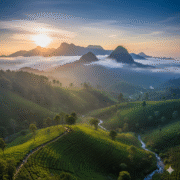
Heeloya Village – A Living Museum of Sri Lanka’s Kandyan Heritage
- November 14, 2025
- eunoialankatours
- 9:20 pm
Tucked away in the misty Dumbara Valley, Heeloya Village is more than just a scenic hamlet—it is a 2,000-year-old storybook of Sri Lanka’s agrarian wisdom, royal patronage, and cultural heritage. Encircled by the emerald peaks of the Knuckles Mountain Range (a UNESCO World Heritage Site), this village preserves traditions that once safeguarded the Kandyan Kingdom and continue to thrive as a living testimony to Sri Lanka’s rural life.
A Valley of Kings and Fertile Lands
In ancient times, Heeloya was considered a jewel of the Kandyan highlands. Its fertile soil and natural fortress-like setting, framed by cascading waterfalls and crystal streams, made it a land of prosperity and protection. Kings lavished their patronage here—most notably King Kirthi Sri Rajasinghe (1747–1782 AD), who developed irrigation canals from the hidden Kaludiya Pokuna (Black Water Pool) to nourish the village’s famed terraced paddy fields. Even today, over 162 hectares of paddy land remain linked to the Sangha, as gifted by the kings, echoing a bond between temple and village life.
Bambaragala Viharaya and Ancient Granaries
The Bambaragala Cave Temple, which has Brahmi inscriptions from the 2nd to 3rd century BC, is a place where history whispers, according to archaeologist Dr. Senarath Paranavitana. The kings gave the temple the land of Heeloya, which was one of the first places where farming and religion came together. The ruins of old granaries and a renovated granary that is still in use show that the community fed both body and spirit with its rich farming.
Wariga Sabhawa – The Ancient Village Council
The Wariga Sabhawa, or clan assembly, is a unique relic of Sri Lanka’s indigenous governance that can be found in Heeloya. In the past, carved stone seats were used by village leaders to talk about religion, defence, irrigation, and social issues. The chief’s raised stone throne is still in good shape, and it has inscriptions that show power. This place is a living classroom that shows how Sri Lanka’s old democracy and legal systems worked long before colonial rule came to the island.
The Sacred Threshing Floors – Kamatha Traditions
The Kamatha, or threshing floor, was not just a place for farming; it was also holy. Before threshing paddy, farmers followed good times, ate vegetarian food, and did rituals. Heeloya is the only place that keeps three kinds of threshing floors:
- Vel Kamatha – temporary fields used between harvests.
- Bim Kamatha – permanent earthen threshing floors near paddy lands.
- Gal Kamatha – stone-built threshing floors, masterpieces of Kandyan engineering, donated by King Kirthi Sri Rajasinghe.
Folklore says that royal elephants carried huge stones to these Gal Kamathas, which are still standing today. During the harvest, villagers sing “Kamath Kavi” (paddy songs) there.
Kadathura Gal Lena – The King’s Secret Cave
People in Kandy remember that the last king hid in the Kadathura Gal Lena, a cave whose entrance was hidden by curtains. You can still see drill marks for hooks today, which show that this was a clever way to get away. This site is full of secrets, and it gives visitors a real connection to the last days of the Kandyan kingdom.
The Natural Jewels of Heeloya
Nature has carved breathtaking spectacles around Heeloya:
- Kaludiya Pokuna (Black Pool) – A 30-meter-deep dark gem under Ran Ella Falls, surrounded by an air of mystery and peace.
- Perumal Wetunu Ella – a charming cascade named after a worker who tragically slipped to his death, now a serene reminder of local folklore.
- Heeloya Stream – It flows almost 14 km from Rangala’s cloud forests, where it supports aquatic life and joins the waters of the Victoria Reservoir.
These landscapes, combined with Podalgoda Oya and Galmal Oya, enrich the paddy fields, making Heeloya an ecological treasure.
Agriculture, Rituals, and Indigenous Knowledge
Buffalo ploughing, using herbal pesticides to control pests naturally, and crop rotations based on the lunar calendar and monsoons are just a few of the sustainable farming methods that have been passed down for generations in Heeloya. From “Goyam Kavi” (ploughing chants) to “Betha Peheema” (winnowing songs), farmers still follow lucky rituals every year. These practices show that indigenous people have a complex way of knowing that balances their spirituality, their way of life, and the environment.
Folk Culture and Living Heritage
Life in Heeloya is enriched by folk music, dances, rituals, and seasonal food traditions. Local households still prepare age-old recipes, cultivate spices and medicinal herbs, and practice bee farming and chena cultivation. Visitors can witness traditional industries, join Kandyan folk games, and experience the authentic village lifestyle, making Heeloya one of the few remaining “living heritage villages” in Sri Lanka’s hill country.
Heeloya for the Modern Traveler
Today, Heeloya is being developed as a model sustainable tourism village under the Department of Trade, Commerce, and Tourism. Visitors can:
- Trek through terraced paddy fields and Knuckles foothills.
- Learn traditional farming and threshing rituals.
- Bathe under waterfalls and explore hidden caves.
- Dine on authentic Kandyan food prepared in village homes.
- Discover folk music, dances, and rituals preserved for generations.
- Support eco-friendly industries by purchasing locally made products.
For researchers, Heeloya is a goldmine of indigenous knowledge. For travelers, it is a rare chance to feel like a local and step into an unbroken chain of tradition.
Why Heeloya Matters
Heeloya is not simply a village—it is Sri Lanka’s living encyclopedia of cultural resilience and ecological harmony. From its ancient inscriptions and royal irrigation feats to its ecological diversity and folk traditions, Heeloya stands as a bridge between the past and future. In a world racing toward modernization, Heeloya reminds us of the importance of preserving sustainable lifestyles and passing them to future generations.


